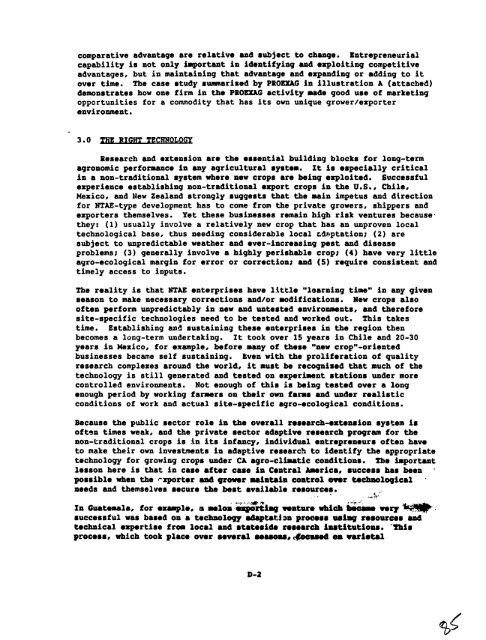MUNZSSInlD - usaid
MUNZSSInlD - usaid
MUNZSSInlD - usaid
You also want an ePaper? Increase the reach of your titles
YUMPU automatically turns print PDFs into web optimized ePapers that Google loves.
comparative advantage are relative and subject to change. Entrepreneurial<br />
capability is not only important in identifying and exploiting competitive<br />
advantages, but in maintaining that advantage and expanding or adding to it<br />
over time. The case study summarised by PROEXAG in illustration A (attached)<br />
demonstrates how one firm in the PROEXAG activity made good use of marketing<br />
opportunities for a commodity that has its own unique grower/exporter<br />
environment.<br />
3.0 THE RIGHT TECHNOLOGY<br />
Research and extension are the essential building blocks for long-term<br />
agronomic performance in any agricultural system. It is especially critical<br />
in a non-traditional system where new crops are being exploited. Successful<br />
experience establishing non-traditional export crops in the U.S., Chile,<br />
Mexico, and New Zealand strongly suggests that the main impetus and direction<br />
for NTAE-type development has to come from the private growers, shippers and<br />
exporters themselves. Yet these businesses remain high risk ventures because<br />
they: (1) usually involve a relatively new crop that has an unproven local<br />
technological base, thus needing considerable local Ldbptation; (2) are<br />
subject to unpredictable weather and ever-increasing pest and disease<br />
problems; (3) generally involve a highly perishable crop; (4) have very little<br />
agro-ecological margin for error or correction; and (5) require consistent and<br />
timely access to inputs.<br />
The reality is that NTAE enterprises have little "learning time" in any given<br />
season to make necessary corrections and/or modifications. New crops also<br />
often perform unpredictably in new and untested environments, and therefore<br />
site-specific technologies need to be tested and worked out. This takes<br />
time. Establishing and sustaining these enterprises in the region then<br />
becomes a long-term undertaking. It took over 15 years in Chile and 20-30<br />
years in Mexico, for example, before many of these "new crop"-oriented<br />
businesses became self sustaining. Even with the proliferation of quality<br />
research complexes around the world, it must be recognized that much of the<br />
technology is still generated and tested on experiment stations under more<br />
controlled environments. Not enough of this is being tested over a long<br />
enough period by working farmers on their own farms and under realistic<br />
conditions of work and actual site-specific agro-ecological conditions.<br />
Because the public sector role in the overall research-extension system is<br />
often times weak, and the private sector adaptive research program for the<br />
non-traditional crops is in its infancy, individual entrepreneurs often have<br />
to make their own investments in adaptive research to identify the appropriate<br />
technology for growing crops under CA agro-climatic conditions. The important<br />
lesson here is that in case after case in Central America, success has been<br />
possible when the -xporter and grower maintain control over technological<br />
needs and themselves secure the best available resources.<br />
In Guatemala, for example, a melon eqoitia venture whch became very<br />
successful was based on a technology adaptation process using resources and<br />
technical expertise from local and stateside research institutions. 'This<br />
process, which took place over several seasoas,4locused on varietal<br />
D-2

















